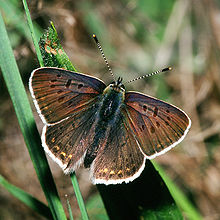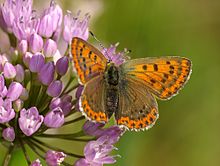Brown fire butterfly
| Brown fire butterfly | ||||||||||||
|---|---|---|---|---|---|---|---|---|---|---|---|---|

Brown fire butterfly ( Lycaena tityrus ) |
||||||||||||
| Systematics | ||||||||||||
|
||||||||||||
| Scientific name | ||||||||||||
| Lycaena tityrus | ||||||||||||
| ( Poda , 1761) |
The brown fire butterfly ( Lycaena tityrus ), also called sulfur bird, is a butterfly (day butterfly ) from the family of the bluebells (Lycaenidae).
features
butterfly
The moths have a wingspan of 30 to 40 millimeters and show pronounced sexual dichroism . The upper sides of the wings of the male animals are dark brown with a faint blue-green sheen. The edges of the wings have a white fringe. The forewings of the females, on the other hand, are colored orange on the upper side and have black spots, while the hind wings are colored brown on the upper side and have a band of orange spots. The undersides of the wings are yellow-brown and marked with black spots and orange spots on the edge. The German name of this species is due to the almost sulfur-yellow color of the underside of the wing in the second generation of butterflies.
Caterpillar
The caterpillars have a stocky green body.
Flight time
The first generation flies in late April to June, the second generation from July to September. Several generations occur in hot, lower elevations from mid-April to the end of October.
habitat
The habitats of the sulfur bird include flowery, poor, near-natural meadows, dry areas with shrub growth, moist forest clearings and protected mountain gorges.
Way of life
Rumex species, especially the common sorrel ( Rumex acetosa ), serve as forage for the caterpillars . It overwinters at the base of the forage plant. Due to the intensive use of meadows through grazing , drainage and fertilization , the caterpillar forage plants have been greatly reduced in their occurrence.
The moths suckle on the daisy family .
distribution
The brown fire butterfly is distributed from northern Spain ( Cantabrian Mountains , Pyrenees ) to Lithuania at altitudes of 50 to 2,500 meters. However, it does not occur in Great Britain , Scandinavia and the Mediterranean islands (except Sicily and Samos ).
swell
Individual evidence
- ↑ Tom Tolman, Richard Lewington: The butterflies of Europe and Northwest Africa . Franckh-Kosmos, Stuttgart 1998, ISBN 3-440-07573-7 .
literature
- Hans-Josef Weidemann: Butterflies: observe, determine . Naturbuch-Verlag, Augsburg 1995, ISBN 3-89440-115-X .
- Butterflies. 2. Special part: Satyridae, Libytheidae, Lycaenidae, Hesperiidae . In: Günter Ebert, Erwin Rennwald (eds.): The butterflies of Baden-Württemberg . 1st edition. tape 2 . Ulmer, Stuttgart (Hohenheim) 1991, ISBN 3-8001-3459-4 .
- Manfred Koch : We determine butterflies. Volume 1: Butterfly. 4th enlarged edition. Neumann, Radebeul / Berlin 1966, DNB 457244224 .
- Elizabeth Balmer: Butterflies: Recognizing and Identifying. Parragon Books Ltd., Cologne 2007 ISBN 978-1407512037 , p. 80


